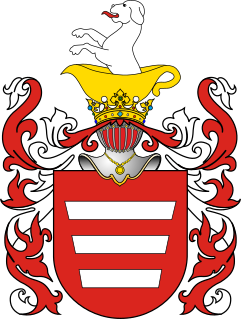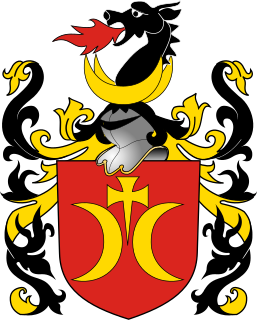
Marchocki of the Ostoja coat of arms was a Polish senatorial noble family.

Marchocki of the Ostoja coat of arms was a Polish senatorial noble family.

Topór is a Polish coat of arms. It was used by several szlachta (noble) families in medieval Poland and under the Polish–Lithuanian Commonwealth.

Prince Karol Stanisław Radziwiłł was a Polish nobleman, diplomat and prince of the Commonwealth. He is frequently referred to by his well-known sobriquet Panie Kochanku to distinguish him from his earlier namesake. Prince Radziwiłł held several important posts; from 1752 he was the Master Swordbearer of the Lithuania, and in 1757 he became one of the first recipients of the Order of the White Eagle. From 1762 he was Voivode of Vilnius.

Prince Michał Fryderyk Czartoryski (1696–1775) was a Polish nobleman, the Duke of Klewań and Żuków, magnate, and Knight of the Order of the White Eagle. He headed Poland's Czartoryski "Familia".

The Kiev Voivodeship was a unit of administrative division and local government in the Grand Duchy of Lithuania from 1471 until 1569 and of the Crown of the Kingdom of Poland from 1569 until 1793, as part of Lesser Poland Province of the Polish Crown.

Franciszek Salezy Potocki (1700–1772) was a Polish nobleman, diplomat, politician and knight of the Order of the White Eagle, awarded on August 3, 1750 in Warsaw. Potocki was the wealthiest magnate of his time and the owner of large properties in Dnieper Ukraine, then part of the Polish Crown. Nicknamed "Little King of Ruthenia".

Prokop Sieniawski was a Polish noble.

Achinger is a Polish coat of arms. It was used by several szlachta families in the times of the Kingdom of Poland and the Polish–Lithuanian Commonwealth.

Karol Tarło (1639–1702) was voivode of the Lublin Voivodeship in the years 1685–1689 as well as a Crown Chancellor of Poland in the years1639-1702.
Mikołaj Złotnicki was King's Cup-Bearer of the Crown since 1688.

Krupski - Polish noble (szlachta) family from Eastern Europe and a common surname in modern Poland.

Michał Wielhorski h. Kierdeja was a Polish noble, official, politician, diplomat and writer. He was the Lithuanian Master of the Kitchen in the years 1763–1774, Lithuanian Great Quartermaster in 1758–1762, starost and envoy of the Bar Confederation to France.
Aleksander Dzierzbicki was a Polish szlachcic (nobleman), a chorąży of Inowłódz (1752–1759), a chorąży mniejszy łęczycki (1759), a chorąży większy łęczycki (1759–1763) and a castellan of Brzeziny (1763–1767).
Stefan Ledóchowski, Szaława coat of arms, was Volhynian Podstoli in the years 1720–1727.
Mikołaj Święcicki of the Jastrzębiec coat of arms was from 1697, the Bishop of Kiev, from 1699, the Bishop of Poznań, the chancellor of the Poznań cathedral chapter in 1674–1679, the dean of the Poznań cathedral chapter in 1679-1701 scholastic of the collegiate chapter of Saint. John the Baptist in Warsaw, an official and vicar general in Mazovia in 1684.

Danielewicz family of Clan Ostoja originates probably from Russian boyar Daniel Aleksandrowicz's son Vladimir Danielewicz, that settled down in Lithuania. Danielewicz is a patronymic surname, meaning descendants of Daniel or Danilo. The family is associated with the Clan of Ostoja and Ostoja Coat of Arms.

The Błociszewski family - a Polish noble family with the coat of arms of Ostoja, belonging to the heraldic Clan Ostoja (Moscics), originating from Błociszewo in the former of Kościan district of Poznań voivodeship. From the Błociszewskis of the Ostoja CoA come: Brodnicki, Bytkowski, Gajewski, Lubiatowski, Ptaszkowski, Szczodrowki.

The Danilewicz (Danielewicz) family – a noble family from the Grand Duchy of Lithuania, with the coat of arms of Ostoja, belonging to the heraldic Clan Ostoja (Moscics). The Danilewicz’s were mentioned by Kasper Niesiecki in Herbarz Polski.

The Kiedrzynski family - a Polish noble family with the Ostoja coat of arms, belonging to the heraldic Clan Ostoja (Moscics), originating from Kiedrzyn. Kiedrzyński was mentioned by Kasper Niesiecki in Herbarz Polski.